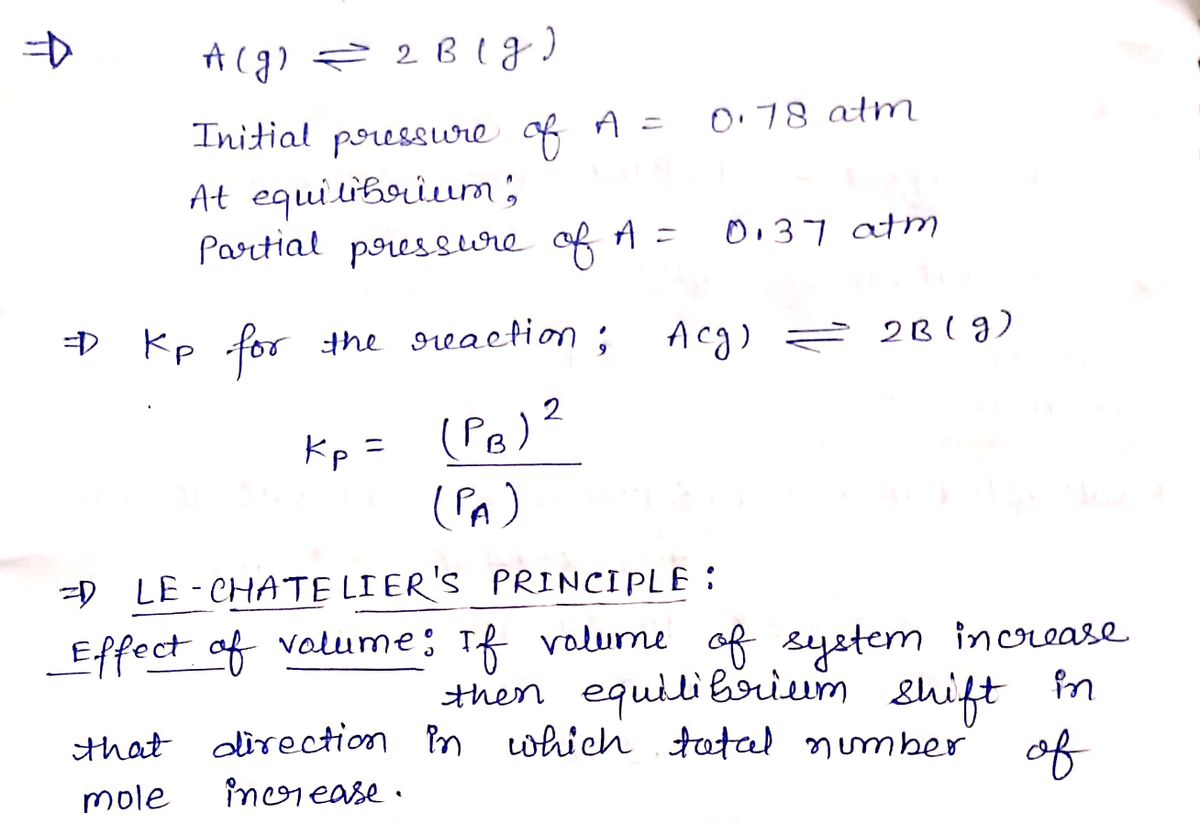→ Consider the hypothetical reaction A(g) + 2B(g). A flask is charged with 0.78 atm of pure A, after which it is allowed to reach equilibrium at 0 °C. At equilibrium the partial pressure of A is 0.37 atm. ▼ What is the total pressure in the flask at equilibrium? Express your answer using two significant figures. 15. ΑΣΦΑ P₁ = Submit Part B What is the value of K₂? Express your answer using two significant figures. Kp = Submit Part C Request Answer IVE ΑΣΦ Submit Request Answer What could we do to maximize the yield of B? ? Request Answer ? O Doing the reaction in a smaller flask maximizes the yield of B. O Doing the reaction in a larger flask maximizes the yield of B. atm
→ Consider the hypothetical reaction A(g) + 2B(g). A flask is charged with 0.78 atm of pure A, after which it is allowed to reach equilibrium at 0 °C. At equilibrium the partial pressure of A is 0.37 atm. ▼ What is the total pressure in the flask at equilibrium? Express your answer using two significant figures. 15. ΑΣΦΑ P₁ = Submit Part B What is the value of K₂? Express your answer using two significant figures. Kp = Submit Part C Request Answer IVE ΑΣΦ Submit Request Answer What could we do to maximize the yield of B? ? Request Answer ? O Doing the reaction in a smaller flask maximizes the yield of B. O Doing the reaction in a larger flask maximizes the yield of B. atm
Chemistry
10th Edition
ISBN:9781305957404
Author:Steven S. Zumdahl, Susan A. Zumdahl, Donald J. DeCoste
Publisher:Steven S. Zumdahl, Susan A. Zumdahl, Donald J. DeCoste
Chapter1: Chemical Foundations
Section: Chapter Questions
Problem 1RQ: Define and explain the differences between the following terms. a. law and theory b. theory and...
Related questions
Question
27. Please see attached image

Transcribed Image Text:→
Consider the hypothetical reaction A(g) + 2B(g). A
flask is charged with 0.78 atm of pure A, after which it
is allowed to reach equilibrium at 0 °C. At equilibrium
the partial pressure of A is 0.37 atm.
What is the total pressure in the flask at equilibrium?
Express your answer using two significant figures.
15. ΑΣΦΑ 1
P₁ =
Submit
Part B
What is the value of K₂?
Express your answer using two significant figures.
Kp =
Submit
Part C
Request Answer
[ΕΙ ΑΣΦ
Submit
Request Answer
What could we do to maximize the yield of B?
?
Request Answer
?
O Doing the reaction in a smaller flask maximizes the yield of B.
O Doing the reaction in a larger flask maximizes the yield of B.
atm
Expert Solution
Step 1

Trending now
This is a popular solution!
Step by step
Solved in 3 steps with 3 images

Knowledge Booster
Learn more about
Need a deep-dive on the concept behind this application? Look no further. Learn more about this topic, chemistry and related others by exploring similar questions and additional content below.Recommended textbooks for you

Chemistry
Chemistry
ISBN:
9781305957404
Author:
Steven S. Zumdahl, Susan A. Zumdahl, Donald J. DeCoste
Publisher:
Cengage Learning

Chemistry
Chemistry
ISBN:
9781259911156
Author:
Raymond Chang Dr., Jason Overby Professor
Publisher:
McGraw-Hill Education

Principles of Instrumental Analysis
Chemistry
ISBN:
9781305577213
Author:
Douglas A. Skoog, F. James Holler, Stanley R. Crouch
Publisher:
Cengage Learning

Chemistry
Chemistry
ISBN:
9781305957404
Author:
Steven S. Zumdahl, Susan A. Zumdahl, Donald J. DeCoste
Publisher:
Cengage Learning

Chemistry
Chemistry
ISBN:
9781259911156
Author:
Raymond Chang Dr., Jason Overby Professor
Publisher:
McGraw-Hill Education

Principles of Instrumental Analysis
Chemistry
ISBN:
9781305577213
Author:
Douglas A. Skoog, F. James Holler, Stanley R. Crouch
Publisher:
Cengage Learning

Organic Chemistry
Chemistry
ISBN:
9780078021558
Author:
Janice Gorzynski Smith Dr.
Publisher:
McGraw-Hill Education

Chemistry: Principles and Reactions
Chemistry
ISBN:
9781305079373
Author:
William L. Masterton, Cecile N. Hurley
Publisher:
Cengage Learning

Elementary Principles of Chemical Processes, Bind…
Chemistry
ISBN:
9781118431221
Author:
Richard M. Felder, Ronald W. Rousseau, Lisa G. Bullard
Publisher:
WILEY